 W
WA light machine gun (LMG) is an intermediate cartridge machine gun designed to be employed by an individual soldier, with or without an assistant, as an infantry support weapon. Light machine guns are often used as squad automatic weapons.
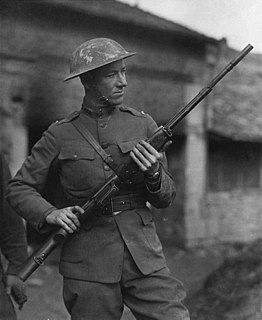 W
WAn automatic rifle is a type of self-loading rifle that is capable of automatic fire. Automatic rifles are select-fire weapons that are capable of firing in semi-automatic and automatic firing modes. Automatic rifles are distinguished from semi-automatic rifles in their ability to fire more than one shot in succession once the trigger is pulled. Most automatic rifles are further subcategorized as battle rifles or assault rifles.
 W
WThe Fucile Mitragliatore Breda modello 30 was the standard light machine gun of the Royal Italian Army during World War II.
 W
WThe Breda 5C was an Italian medium machine gun, which was adopted by the Royal Italian Army and used in the Second Italo-Ethiopian War and in World War II.
 W
WThe Bren gun was a series of light machine guns (LMG) made by Britain in the 1930s and used in various roles until 1992. While best known for its role as the British and Commonwealth forces' primary infantry LMG in World War II, it was also used in the Korean War and saw service throughout the latter half of the 20th century, including the 1982 Falklands War. Although fitted with a bipod, it could also be mounted on a tripod or be vehicle-mounted.
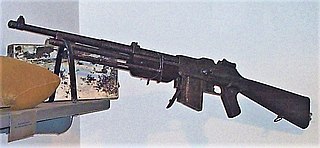 W
WThe Browning wz.1928 is a Polish version of the M1918 BAR. It was a Light machine gun used by the Poles in World War II.
 W
WThe Charlton Automatic rifle was a fully automatic conversion of the Lee–Enfield rifle, designed by New Zealander Philip Charlton in 1941 to act as a substitute for the Bren and Lewis gun light machine guns which were in severely short supply at the time.
 W
WThe Chauchat was the standard light machine gun or "machine rifle" of the French Army during World War I (1914–18). Its official designation was "Fusil Mitrailleur Modele 1915 CSRG". Beginning in June 1916, it was placed into regular service with French infantry, where the troops called it the FM Chauchat, after Colonel Louis Chauchat, the main contributor to its design. The Chauchat in 8mm Lebel was also extensively used in 1917–18 by the American Expeditionary Forces (A.E.F.), where it was officially designated as the "Automatic Rifle, Model 1915 (Chauchat)". A total of 262,000 Chauchats were manufactured between December 1915 and November 1918, including 244,000 chambered for the 8mm Lebel service cartridge, making it the most widely manufactured automatic weapon of World War I. The armies of eight other nations—Belgium, Finland, Greece, Italy, Poland, Romania, Russia, and Serbia—also used the Chauchat machine rifle in fairly large numbers during and after World War I.
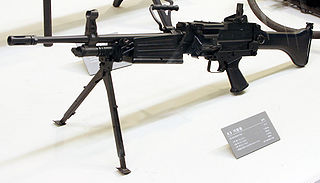 W
WThe Daewoo Precision Industries K3 is a South Korean light machine-gun. It is the third indigenous firearm developed in South Korea by the Agency for Defense Development, following the Daewoo Precision Industries K1 submachine gun and Daewoo Precision Industries K2 assault rifle. It is manufactured by Daewoo Precision Industries, current S&T Motiv. The K3 is capable of firing both 5.56×45mm NATO and .223 Remington rounds like the K2 assault rifle. The K3 light machine gun entered service since 1989, replacing M60 machine gun from frontline use.
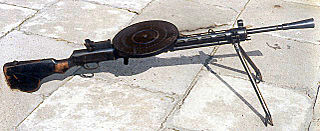 W
WThe Degtyaryov machine gun or DP-27 is a light machine gun firing the 7.62×54mmR cartridge that was primarily used by the Soviet Union, with service trials starting in 1927 followed by general deployment in 1928.
 W
WThe Dror light machine gun was an Israeli light machine gun based on the M1941 Johnson light machine gun.
 W
WThe FG 42 is a selective-fire 7.92×57mm Mauser automatic rifle produced in Nazi Germany during World War II. The weapon was developed specifically for the use of the Fallschirmjäger airborne infantry in 1942 and was used in very limited numbers until the end of the war.
 W
WThe HK21 is a German 7.62 mm general-purpose machine gun, developed in 1961 by small arms manufacturer Heckler & Koch and based on the G3 battle rifle. The weapon is in use with the armed forces of several Asian, African and Latin American countries. It was also license-manufactured by Fábrica de Braço de Prata in Portugal as the m/968 and in Mexico by SEDENA as the MG21. In the German military (Bundeswehr) and the federal police (Bundespolizei) it is designated "G8".
 W
WThe Hotchkiss M1922 was a light machine gun manufactured by Hotchkiss.
 W
WThe Hotchkiss machine gun was any of a line of products developed and sold by Hotchkiss et Cie,, established by United States gunsmith Benjamin B. Hotchkiss. Hotchkiss moved to France and set up a factory, first at Viviez near Rodez in 1867, then at Saint-Denis near Paris in 1875 manufacturing arms used by the French in the Franco-Prussian War.
 W
WThe IMI Galil is a family of Israeli made automatic rifles designed by Yisrael Galil and Yaacov Lior in the late 1960s, and produced by Israel Military Industries (IMI). The design is closely based on the Valmet Rk 62, which is itself an improved version of the Soviet AK-47. The first Galils were manufactured using Valmet Rk 62 receivers. Most Galils are chambered for either the 5.56×45mm NATO or 7.62×51mm NATO cartridges. The Galil series of weapons is in use with military and police forces in over 25 countries.
 W
WThe IWI Negev is a 5.56×45mm NATO light machine gun developed by the Israeli firearm manufacturer, Israel Weapon Industries (IWI), formerly Israel Military Industries Ltd. (IMI) of Ramat HaSharon.
 W
WThe Johnston Model D1918 was a light machine gun. It is a rare and little-known weapon with scant information available on it. It is best known for its resemblance to the Lewis Gun, having a similar gas-operated action and a barrel surrounded by a cooling shroud.
 W
WThe kbkm wz. 2003 or "karabinek maszynowy wzór 2003 is a light machine gun of Polish origin, designed in the early 2000s to replace the 7.62×54mmR PKM series of support weapons. The construction if fully compatible with all NATO standards. There were 2 versions developed of this gun: kbkm. 2003S - standard version and kbkm. 2003D - version for airborne or assault units with shorter barrel. Overall it was put into tests and not purchased by the Polish Army.
 W
WThe KK 62, officially 7.62 KK 62 and colloquially KVKK or KVKK 62, is a Finnish 7.62×39mm light machine gun designed in late 1950s with the first prototype ready for testing in 1960. It was officially adopted as the standard infantry support weapon of the Finnish Defence Forces (FDF) in 1962 as the 7.62 konekivääri 62; the first weapons were delivered in 1966. It remains in service, although a replacement has already entered use, namely the PKM general-purpose machine gun.
 W
WThe LAD machine gun is a Soviet prototype light machine gun. Although belt-fed and having a built-in bipod, it is chambered for the Tokarev pistol cartridge. The LAD machine gun was developed between 1942 and 1943 by V. F. Lyuty, N. M. Afanasyev and V. S. Deykin. Only two prototypes were built and it was not accepted for service.
 W
WThe Lewis gun is a First World War–era light machine gun. Designed privately in America but not adopted, the design was finalised and mass-produced in the United Kingdom, and widely used by troops of the British Empire during the war. It had a distinctive barrel cooling shroud and top-mounted pan magazine. The Lewis served to the end of the Korean War. It was also widely used as an aircraft machine gun, almost always with the cooling shroud removed, during both World Wars.
 W
WThe Browning Automatic Rifle (BAR) is a family of American automatic rifles and machine guns used by the United States and numerous other countries during the 20th century. The primary variant of the BAR series was the M1918, chambered for the .30-06 Springfield rifle cartridge and designed by John Browning in 1917 for the American Expeditionary Forces in Europe as a replacement for the French-made Chauchat and M1909 Benét–Mercié machine guns that US forces had previously been issued.
 W
WThe M1919 Browning is a .30 caliber medium machine gun that was widely used during the 20th century, especially during World War II, the Korean War, and the Vietnam War. The M1919 saw service as a light infantry, coaxial, mounted, aircraft, and anti-aircraft machine gun by the U.S. and many other countries.
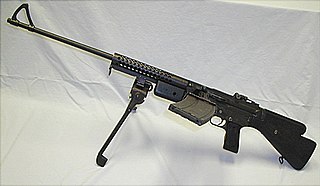 W
WThe M1941 Johnson Light Machine Gun, also known as the Johnson and the Johnny gun, was an American recoil-operated light machine gun designed in the late 1930s by Melvin Johnson. It shared the same operating principle and many parts with the M1941 Johnson rifle and the M1947 Johnson auto carbine.
 W
WThe Sieg automatic rifle was a bullpup automatic rifle designed by Chief Gunner's Mate James E. Sieg of the US Coast Guard. The weapon was chambered in the .30-06 round, fed from 20 round magazines and capable of firing around 650–700 RPM on full automatic. A two-finger double trigger selected between semiautomatic and fully automatic fire. The barrel came with a unique muzzle compensator that could be turned off for use with a flash hider or grenade launcher without interfering with the installation of a bayonet. Recoil gently threw the barrel of the Sieg rifle downward, not upward. When tested at Fort Benning, it had effective results. The compensator was extremely effective; it also enabled the user to fire the rifle with one hand.
 W
WThe Madsen is a light machine gun that Julius A. Rasmussen and Theodor Schouboe designed and proposed for adoption by Colonel Vilhelm Herman Oluf Madsen, the Danish Minister of War, and that the Danish Army adopted in 1902. It was the world's first true light machine gun produced in quantity and Madsen was able to sell it in 12 calibres to over 34 countries. The gun saw extensive combat for over 100 years. The Madsen was produced by Compagnie Madsen A/S.
 W
WThe Maxim–Tokarev was the first domestic Soviet light machine gun accepted for service. It was based on the Maxim M1910.
 W
WThe Mendoza C-1934 was a light machine gun similar to the M1918 BAR manufactured in Mexico. It was chambered in 7 mm calibre and had a 20-round magazine fed from the top.
 W
WThe Mendoza RM2 was a light machine gun similar to the M1918 BAR manufactured in Mexico by Productos Mendoza, S.A.. Rafael Mendoza have been producing machine guns for the Mexican Army since 1933 and all have been noted for their lightness, simplicity, ease of maintenance, and economic construction without sacrificing reliability.
 W
WThe MG 13 is a German light machine gun developed by converting the Dreyse Model 1918 heavy water-cooled machine gun into an air-cooled version.
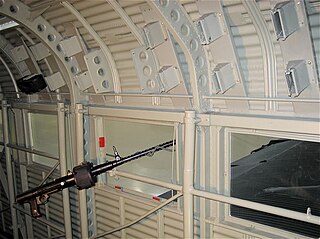 W
WThe MG 15 was a German 7.92 mm machine gun designed specifically as a hand manipulated defensive gun for combat aircraft during the early 1930s. By 1941 it was replaced by other types and found new uses with ground troops.
 W
WThe Maschinengewehr 30, or MG 30 was a German-designed machine gun that saw some service with various armed forces in the 1930s. It was also modified to become the standard German aircraft gun as the MG 15 and MG 17. It is most notable as the design pattern that led to the MG 34 and MG 42, and thus is one of the major ancestors of many of the weapons in service which would later find widespread use into the 21st century.
 W
WThe Rodman Laboratories XM235 was one of the contenders for the Squad Automatic Weapon (SAW) trials in 1975-1976.
 W
WThe Rossignol ENT was an experimental automatic rifle of French origin from the first years of the 20th century. It was the first rifle which used the direct impingement operating system, which found later use in the Swedish Ag m/42 and the French 1940 MAS rifles.
 W
WThe RPD is a 7.62mm light machine gun developed in the Soviet Union by Vasily Degtyaryov for the 7.62×39mm M43 intermediate cartridge. It was created as a replacement for the DP machine gun chambered for the 7.62×54mmR round. It is a precursor of most squad automatic weapons. It was succeeded in Soviet service by the RPK.
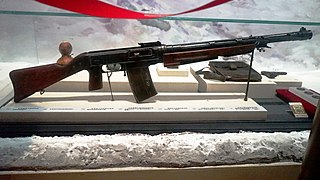 W
WThe SIG KE7 is a light machine gun designed and manufactured in Switzerland in the decade before the Second World War. Although exported, it was never used by the Swiss Army.
 W
WThe Steyr AUG is an Austrian 5.56×45mm NATO bullpup assault rifle, designed in the 1960s by Steyr-Daimler-Puch and now manufactured by Steyr Mannlicher GmbH & Co KG.
 W
WThe T75 Light machine gun is produced by the 205th Arsenal, Ministry of Defense, Republic of China (Taiwan). The T75 is based on the proven Belgian-made FN Minimi LMG incorporating features from the T57 and T74 machine-guns with more modern features. The T75 is slightly heavier but shorter than the Minimi. The T75 is also deployed aboard Republic of China Navy and Coast Guard Administration vessels.
 W
WThe Type 11 light machine gun was a light machine gun used by the Imperial Japanese Army in the interwar period and during World War II.
 W
WThe Type 81 is a Chinese-designed second-generation, selective-fire, gas-operated 7.62×39mm rifle adopted by the Chinese People's Liberation Army (PLA) and has been in service since the mid-1980s.
 W
WThe Type 96 light machine gun was a light machine gun used by the Imperial Japanese Army in the interwar period and in World War II. It was first introduced in 1936, and fires the 6.5x50mm Arisaka from 30-round top-mounted magazines. A combination of unimpressive ballistic performance and a lack of reliability caused the Imperial Japanese Army to try and replace the Type 96 with the Type 99 Light Machine Gun, though both saw major usage until the end of the war.
 W
WThe Type 99 light machine gun was a light machine gun used by the Imperial Japanese Army in World War II.
 W
WThe R4 is a South African 5.56×45mm assault rifle. It entered service as the standard service rifle of the South African Defence Force (SADF) in 1980. The R4 replaced the R1, a variant of the 7.62×51mm FN FAL. It was produced by Lyttelton Engineering Works, now Denel Land Systems.
 W
WThe Vektor SS-77 is a general-purpose machine gun designed and manufactured by Denel Land Systems—formerly Lyttleton Engineering Works (LIW)—of South Africa.
 W
WThe Vickers–Berthier (VB) is a light machine gun that was produced by the British company Vickers-Armstrong. It was adopted by the British Indian Army and saw combat during World War II.
 W
WThe vz. 52 is a Czechoslovak light machine gun developed after the Second World War for the Czechoslovak Armed Forces.
 W
WThe Zastava M72 is a light machine gun developed and manufactured by then Yugoslav Zastava Arms company. Generally, the M72 is almost a direct copy of the Soviet RPK light machine gun, the only visual differences being in barrel, wooden stock, no side rail mount and slightly in design of the wooden handguard.
 W
WThe Zastava M77 is a 7.62mm light machine gun developed and manufactured by Zastava Arms. It is an AK-47 variant.
 W
WThe ZB vz. 26 was a Czechoslovak light machine gun developed in the 1920s, which went on to enter service with several countries. It saw its major use during World War II, and spawned the related ZB vz. 27, vz. 30, and vz. 33. The ZB vz. 26 influenced many other light machine gun designs including the British Bren light machine gun and the Japanese Type 96 Light Machine Gun. The ZB-26 is famous for its reliability, simple components, quick-change barrel and ease of manufacturing. This light machine gun in the Czechoslovak army was marked as the LK vz. 26. ZB vz. 26 is incorrect nomenclature because "ZB-26" is a factory designation, while "vzor 26" or "vz. 26" is an army designation.
 W
WThe ZB-30 and ZB-30J were Czechoslovakian light machine guns that saw extensive use during World War II.